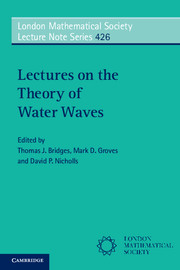Book contents
- Frontmatter
- Contents
- Contributors
- Preface
- 1 High-Order Perturbation of Surfaces Short Course: Boundary Value Problems
- 2 High-Order Perturbation of Surfaces Short Course: Traveling Water Waves
- 3 High-Order Perturbation of Surfaces Short Course: Analyticity Theory
- 4 High-Order Perturbation of Surfaces Short Course: Stability of Traveling Water Waves
- 5 A Novel Non-Local Formulation of Water Waves
- 6 The Dimension-Breaking Route to Three-Dimensional Solitary Gravity-Capillary Water Waves
- 7 Validity and Non-Validity of the Nonlinear Schrödinger Equation as a Model for Water Waves
- 8 Vortex Sheet Formulations and Initial Value Problems: Analysis and Computing
- 9 Wellposedness and Singularities of the WaterWave Equations
- 10 Conformal Mapping and Complex Topographies
- 11 Variational Water Wave Modelling: from Continuum to Experiment
- 12 Symmetry, Modulation, and Nonlinear Waves
- References
10 - Conformal Mapping and Complex Topographies
Published online by Cambridge University Press: 05 February 2016
- Frontmatter
- Contents
- Contributors
- Preface
- 1 High-Order Perturbation of Surfaces Short Course: Boundary Value Problems
- 2 High-Order Perturbation of Surfaces Short Course: Traveling Water Waves
- 3 High-Order Perturbation of Surfaces Short Course: Analyticity Theory
- 4 High-Order Perturbation of Surfaces Short Course: Stability of Traveling Water Waves
- 5 A Novel Non-Local Formulation of Water Waves
- 6 The Dimension-Breaking Route to Three-Dimensional Solitary Gravity-Capillary Water Waves
- 7 Validity and Non-Validity of the Nonlinear Schrödinger Equation as a Model for Water Waves
- 8 Vortex Sheet Formulations and Initial Value Problems: Analysis and Computing
- 9 Wellposedness and Singularities of the WaterWave Equations
- 10 Conformal Mapping and Complex Topographies
- 11 Variational Water Wave Modelling: from Continuum to Experiment
- 12 Symmetry, Modulation, and Nonlinear Waves
- References
Summary
Abstract
Many interesting research problems consider long water waves interacting with highly disordered bottom topographies. The topography profile can be of large amplitude, not smooth and rapidly varying. Disordered topographies do not have a well defined structure and therefore can be modelled as a random coefficient in the wave equations. A summary of results that arise through random modelling is provided. The main goal of this article is to present the Schwarz-Christoffel conformal mapping as a tool for dealing with these problems. Both from the theoretical point of view as well as regarding computational aspects that make use of the Schwarz-Christoffel Toolbox, developed by T. Driscoll.
Introduction and Mathematical Motivation
About 25 years ago we became interested in studying the effects of small scale features of a topography on long waves propagating on the water surface for large distances, such as a tsunami. Our goal was to study solitary waves over rapidly varying disordered topographies. At the time the theory for linear acoustic waves over rapidly varying (one dimensional-1D) layered media was maturing and becoming quite sophisticated [1, 2]. The theory developed by George Papanicolaou and collaborators considered linear hyperbolic systems with disordered rapidly varying coefficients as a model to understand linear pulse-shaped waves travelling in a medium with a random propagation speed. This setup is very useful for understanding the effect of uncertainty on a travelling wave, in direct and inverse problems related to the Earth's subsurface. Mathematically it called for new technology showing that random modelling produced some universal results of interest. These included effective wave propagation properties that were independent of a specific realisation. To study linear travelling waves in the presence of random multiple scattering, Papanicolaou and collaborators developed an asymptotic theory for stochastic ordinary differential equations (SODEs) regarding the transmitted and reflected signals. Limit theorems for randomly forced oscillators characterised asymptotically the expected value for the transmitted and reflected signals after the wave had propagated for large distances. Three scales are involved in this analysis: the medium's microscale ε2, the pulse's characteristic width ε (the mesoscale) and the large propagation distance O(1) (the macroscale).
- Type
- Chapter
- Information
- Lectures on the Theory of Water Waves , pp. 203 - 225Publisher: Cambridge University PressPrint publication year: 2016
References
- 1
- Cited by

